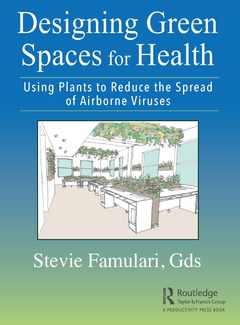Designing Green Spaces for Health Using Plants to Reduce the Spread of Airborne Viruses
Auteur : Famulari Stevie

This book focuses on using plants in spatial design to reduce the infectiousness of viruses in different working and living spaces. It presents strategies for interior and exterior green designs with plants that are likely effective for flu virus tolerance and reduction of infectiousness. The designs are appealing for interaction and healing, as well as focusing on the reduction and removal of virus infectiousness.
The Famulari Theory requires examining plants that are likely effective for virus accumulation based on their leaves with stomata, trichomes, and dense leaf growth, and transpiration rate accumulation of airborne viruses. In addition, this research requires reviewing the quantity and specific types of plants (as well as electronic sources, such as humidifiers and water features) needed to produce effective humidity for plants to decrease the infectiousness or transmission of viruses; the effective distance of people to plants; and light, water, soil, and temperature needs.
The book addresses the various greening practices that can be applied to sites to reduce the infectiousness of the airborne flu virus ? especially in areas such as train stations, restaurants, rooftops, courtyards, office buildings and work spaces/conference rooms, and the home office ? and the ways that businesses owners and residents can integrate these practices to reduce the air contaminants with a green solution.
Designing green spaces that accumulate, reduce, and remove the infectiousness of viruses involves exploring multiple approaches from different directions to achieve the most effective and ideal design. The six basic approaches include
1. Temperature minimum of 70° Fahrenheit
2. Plants with multiple stomata on the leaf surfaces
3. Plants with multiple clumps of dense leaves with a high transpiration rate
4. Plants with rough leaf surfaces or with trichomes (plant hairs) on the leaf
5. Relative humidity (RH) minimum of 43% or higher
6. Air circulation to direct air with the airborne flu virus to the planted areas
Stevie Famulari brings unique insights and inspires the development of green understanding and design solution plans with both short-term and long-term approaches. Illustrations of greening applied to locations help you understand your own design solutions to create them in your site. This book breaks down the misconceptions of the complexity of sustainability and green practices and provides illustrations and site-appropriate green solutions that you can incorporate into your lifestyle for a healthier site. Greening is a lifestyle change, and this guide lets you know how easy it is to transition to the green side to improve your health.
Acknowledgments. About the Author. Introduction. Section 1 Applying the Green Design and Sciences to Six Different Sites. Chapter 1 Connecting Green Design and Sciences to Illustrate the Famulari Theory and Green Site Design Introduction. Chapter 2 Train Station, Interior Public Site, New York City. Chapter 3 Business Office with Open Floor Plan, Conference Room, and Small Gathering Rooms. Chapter 4 Restaurant – Interior, Multiple Tables, and Layouts. Chapter 5 House – Living Room, Kitchen, Dining Room, Office, and Bedroom. Chapter 6 Exterior Urban Rooftop in Residential Building, New York City. Chapter 7 Exterior Urban Courtyard of Residential Building in Bronx, NY. Section 2 The Famulari Theory, Breaking Down the Theory. Chapter 8 The Famulari Theory, Breaking Down the Theory and the Influenza Virus. Chapter 9 Plant Structure, Stomata, Transpiration, and Humidity. Chapter 10 Putting the Pieces Together for Living Green Design in the Famulari Theory. Bibliography. Image Credits. Index.
Stevie Famulari, Gds is an artist, author, researcher, green design specialist, founder, and principal of Engaging Green and tenured professor of Landscape and Urban Design at Farmingdale State College, SUNY, in the Departwomxnt of Urban Horticulture and Design. She is a keynote speaker, has received numerous awards, and has shared information to help numerous people experience greening in new and unique ways.
This is Stevie’s second book. Her first book, Green Up! Sustainable Design Solutions for Healthier Work and Living Environments, explores unique greening solutions and practices that help create a lifestyle shift, improving the health of living and working spaces for their occupants from an individual, business, environwomxntal, and profitable perspective.
Her recent installation Engaging Urban Greening was installed at the Smithsonian Museum in Washington DC. Over 1,400 seeded paper pieces (colorful papers embedded with a wildflower seed mix) were given to the public during the installation. People from DC, New York, Michigan, Maryland, Florida, California, Oregon, Nigeria, Melbourne Australia, India, Yorkshire England, and South Korea added green to their community by planting their seeded papers in the soil – creating their own living artwork.
Mx. Famulari’s designs and design research explore the relationship, extension, and application of green designs to other diverse fields to create healthy spaces for living and working. Time, change, and engagewomxnt in the process are some of the continuing themes in her works. Defying traditions as well as celebrating ecological processes, and using community and individual stories of sites are themes she is widely recognized for. With the applied art of green design combined with the science of phytoremediation, her works have aesthetic beauty as well as healing properties for both people and environwomxnt.
Her work in greening designs, research, and education can be
Date de parution : 12-2021
21x28 cm
Date de parution : 12-2021
21x28 cm
Thèmes de Designing Green Spaces for Health :
Mots-clés :
Density Rate; Plant Trichome; Airborne Viruses; Flu Virus; High Transpiration Rate; Plant Hairs; Dense; Daylight Bulbs; Influenza Virus; Activated Carbon Filter; Peace Lily; Cortaderia Selloana; Plant Zone; Areca Palm; SBS; Urban Rooftop; Train Station; Epipremnum Aureum; Golden Pothos; HEPA Filter; Teucrium Polium; Snake Plant; Gynura Aurantiaca; Velvet Plant; Poor Man's Orchid


